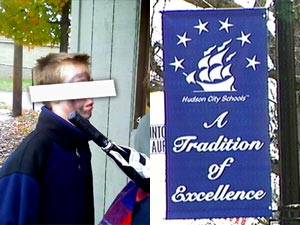Thanks, bro: a “racially themed” frat party at Johns Hopkins University
(Story thanks to a tip from Lisa Casanova.)
Campus life in America
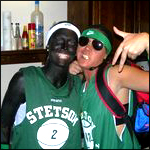
Stetson University, Halloween 2005
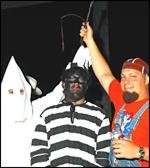
Oklahoma State, September 2002
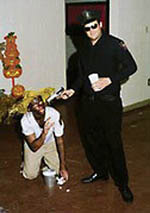
Ole Miss, Halloween 2001.

Auburn, Halloween 2001.
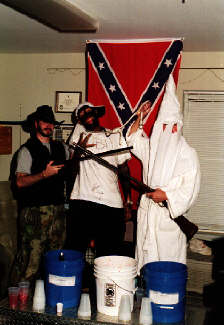
Auburn, Halloween 2001.
It’s early November; that means it’s time for yet another isolated incident at a Halloween party on yet another college campus. This one comes to us thanks to the brothers of Sigma Chi at Johns Hopkins University:
BALTIMORE – Johns Hopkins University suspended a fraternity Monday afternoon following a racially themed Halloween party Saturday night at an off-campus house.
Members of the Black Student Union and supporters rallied on North Charles Street in front of the campus, speaking out against the local Sigma Chi chapter and perceived racial hostility on campus. Hopkins is investigating the party and said the national Sigma Chi fraternity has imposed a 45-day suspension of the chapter's activities and will conduct its own investigation.
The uproar began shortly after the
Halloween in the 'Hoodparty was advertised on the Web site Facebook.com. The invitation encouraged racial-stereotyping costumes, included references to the late attorney Johnnie Cochran and O.J. Simpson, and prefaced descriptions of Baltimore asa ghetto,the hoodandthe HIV pitwith a four-letter epithet.The invitation was attributed to Justin H. Park, who is listed as a Sigma Chi Class of 2008 member on the fraternity's Web site.
Johns Hopkins said in a written statement that the Greek life coordinator had told the chapter president last week that he found the advertisement racist and offensive, and directed the fraternity to withdraw the advertising immediately, but it reappeared without the coordinator's knowledge, in an altered but still offensive form.
… A small group of black students went to the party and said white students were dressed as pimps, prostitutes — and slaves. Outside the front door of the house in the 200 block of East 33rd Street was a plastic skeleton dressed as a pirate, hanging from a rope noose.
And then as you walked up to the house, you heard fake gunshots — as if there is a gun fight in this neighborhood every night,said freshman Blake Edwards, 18.The noose is extremely offensive and makes a mockery of the minority students that go to school here. Several of the girls I went with left in tears.
The entire city of Baltimore should be offended by this.
Here is the text of one of the invitations posted to FaceBook by Justin Park. I don’t have access to FaceBook so my information is limited, but I gather that this is the revised version:
OMG RACIST officially invites you to this delightful gaiety in honor of the last day of October, held in the exquisite metropolis paradise that we affectionately refer to as the
mother-f*cking ghetto,akathe hoodor as I like to call it,the hiv pit.Refreshments include Foie Gras, Belgian Caviar, and Cambodian Breast Milk.
Ornate antique bathtubs full of Evian and Perrier will be provided for your bathing pleasure.
Admission to this bonanza is contingent on appropriate accourtrement – regional clothing from our locale is recommended. These include, but are not limited to, fur coats, copious amounts of so-called
bling bling ice icegrills, hoochie hoops, white Tee’s and Air Force Onez.There will be special
accoladesto those attired in the most conniving and despicable outfits.OMG RACIST would like you to know that he does not condone or advocate racism, fascism, communism, consumerism, capitalism, terrorism, organism(s), sexism, womanism, jism, or any other -ism’s.
For the record, we would like to thank our founding fathers for incorporating the first amendment into the venerable Bill of Rights, and Johnnie L. Cochran for being a true homie and getting Orenthal Simpson, commonly known as OJ, acquitted.
ps we STILL don’t discriminate against hoodrats, skig skags, or scallywops.
Just about every year, right around now. I get to hear the same thing again: a bunch of students, most of them white, threw a party involving blackface costumes and other forms of crude racist caricature. It happened at Auburn–at least twice. It happened at Ole Miss. It happened at Syracuse. It happened at Oklahoma State. It happened at Stetson. It doesn’t always happen at a fraternity party, but it often does. Sometimes the kids opt for broad pastiches of gangsta
images that they’ve picked up from MTV. Sometimes they opt for explicit references to the history of slavery and militant white supremacy. Sometimes–as it seems happened in Baltimore–they opt for both. The pattern is established, and the reactions are reliable. While University administrators are busy rushing to make a public example of whoever was caught throwing the party, and anxiously insisting (to anybody who cares to listen) that this is an isolated incident, not representative of the campus culture, etc. etc. etc., it’s left to those who know something about what actually goes on on campus (usually Black students or faculty) to point out, yet again, that these things happen in a broader context, that this is nothing new, that things like this happen all the time on campus, and that the only thing special about this case is that the story went public. Then a few months later, everything settles back down, the administration eases or completely reverses its disciplinary actions against the fraternity, and we wait until late next October or early next November, when exactly the same damned thing happens at yet another Halloween party somewhere else.
Just this last weekend I was driving to work, just south of the University of Michigan campus, looking at the party-goers wandering to campus Halloween parties in their costumes. And I drove through the streets wondering whether I’d be seeing the Klan robes, the nooses, the blacked-up white boys dressed as slaves, or the thug
poses and afro
wigs and the insufferable grins. And wondering, if I didn’t see it, whether it was going on somewhere else, out of my sight, where it would hit the papers in a few days. I was worrying about all these things when I should have been enjoying the simple, silly joy of people dressing up for the night because every fucking year I can fully expect to hear another story about another racist party, just about now. Over and over again.
Thanks a lot, guys. You have officially ruined Halloween.
